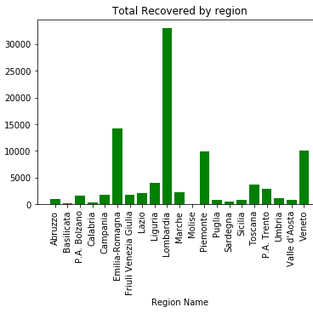COVID-19: An insight into Italy
- ttjakata
- May 12, 2020
- 5 min read
The world is currently undergoing a state of emergency due to the COVID-19 pandemic. Following notification of cases of pneumonia of unknown cause in Wuhan city, China , on December 31st 2019, a novel coronavirus (2019-nCov) was identified as the virus that causes COVID-19 illness on January 9th 2020(source:www.who.int). On 11 and 12 January WHO was notified by National Health Commission China that the outbreak had links to the exposures in one seafood market in Wuhan City. On 13 January 2020 Thailand reported the first imported case of lab-confirmed 2019-novel coronavirus(2019-ncov) from Wuhan City, the first case outside of China. By 20th January more than 280 cases had been reported from four countries: China, Thailand, Japan and the Republic of Korea. Since then the spread and rate of infection has been tremendous worldwide with over 4 million lab-confirmed cases and over 200 thousand deaths.
Italy, one of the hardest hit countries in the world has seen the worst of the pandemic. As reported by European Center for Disease Control and Prevention (ECDC), the first confirmed cases were recorded in Lombardy region on 22 February 2020. Italy falls among the top 5 ranking countries with the highest recorded number of COVID-19 laboratory confirmed and deaths. As of date the number of confirmed cases is above 200 thousand while death toll has exceeded 26 thousand (source: www.worldometers.info). In this post we have decided to give some insight into Italy COVID-19 situation analysis. We have used the dataset from https://www.kaggle.com/sudalairajkumar/covid19-in-italy#covid19_italy_region.csv. It is aggregated by different regions in Italy and composes of 17 columns. The dataset is dated from 24 February 2020 and has been updated on a daily basis until the current date.
1. EXPLORATORY DATA ANALYSIS
In this section we will implore codes to import our dataset and explore it's attributes but first we are going to import some Python packages we will need for our analysis.
#let us begin by importing packages:
import pandas as pd
import matplotlib.pyplot as plt
import numpy as np
import seaborn as snsdf = pd.read_csv(r'C:\Users\covid19_italy_region.csv', parse_dates=['Date'])To view the first five rows of our dataframe we run:
df.head()To view data type for all columns we run:
df.info()
:<class 'pandas.core.frame.DataFrame'>
RangeIndex: 1533 entries, 0 to 1532
Data columns (total 17 columns):
# Column Non-Null Count Dtype
--- ------ -------------- -----
0 SNo 1533 non-null int64
1 Date 1533 non-null datetime64[ns]
2 Country 1533 non-null object
3 RegionCode 1533 non-null int64
4 RegionName 1533 non-null object
5 Latitude 1533 non-null float64
6 Longitude 1533 non-null float64
7 HospitalizedPatients 1533 non-null int64
8 IntensiveCarePatients 1533 non-null int64
9 TotalHospitalizedPatients 1533 non-null int64
10 HomeConfinement 1533 non-null int64
11 CurrentPositiveCases 1533 non-null int64
12 NewPositiveCases 1533 non-null int64
13 Recovered 1533 non-null int64
14 Deaths 1533 non-null int64
15 TotalPositiveCases 1533 non-null int64
16 TestsPerformed 378 non-null float64
dtypes: datetime64[ns](1), float64(3), int64(11), object(2)
memory usage: 203.7+ KBTo view summary statistics of our dataframe we run:
df.describe()1.1 Plots by region
In this section we will plot total positive cases, total deaths and total recovered against region to view distribution of the aggregated incidences by different regions. We will use matplotlib bar plots.
#total positive cases by region name:
fig, ax = plt.subplots()
ax.bar(df['RegionName'],df['TotalPositiveCases'])
ax.set_xlabel('Region Name')
ax.set_xticklabels(df['RegionName'], rotation=90)
ax.set_ylabel('Positive Cases (Cum.)')
ax.set_title('Total Positive Cases by region')# plot of total deaths by region:
fig, ax = plt.subplots()
ax.bar(df['RegionName'],df['Deaths'], color='red')
ax.set_xlabel('Region Name')
ax.set_xticklabels(df['RegionName'], rotation=90)
ax.set_ylabel('Deaths')
ax.set_title('Total deaths by region')#total recoveries by region:
fig, ax = plt.subplots()
ax.bar(df['RegionName'],df['Recovered'], color='green')
ax.set_xlabel('Region Name')
ax.set_xticklabels(df['RegionName'], rotation=90)
ax.set_ylabel('Recovered')
ax.set_title('Total Recovered by region')We see from the plots that Lombardia has the highest cases in Italy followed by Emilia-Romagma.
2.2. ANALYSIS OF THE KEY INDICATORS
We have seen the distribution of total positive cases, total deaths and total recoveries in part 1. In section let us try to run our analysis basing ourselves on some of the key indicators related to the spread, distribution and occurance of the COVID-19 pandemic. We will run our analysis trying to address the following 3 factors; 2.1 How postive cases, deaths and recoveries changed over time(trend analysis). 2.2 Determine the distribution of cases by percentage hospitalized and percentage at home-confinement and the possible reasons behind the observations 2.3 Determine the differences between final outcomes and the possible causes to observed differences.
2.1 Trend analysis
In this section we view how total hospitalized cases, total deaths and total recoveries have changed over time, we will implore matplotlib plots:
fig, ax = plt.subplots()
ax.plot(df['Date'], df['TotalHospitalizedPatients'])
ax.set_xlabel('Time')
ax.set_ylabel('Total Hospitalized (Hospitalized + IntensiveCare)')
ax.set_title('Total Hospitalized Overtime')
plt.show()fig, ax = plt.subplots()
ax.plot(df['Date'], df['Deaths'], color='red')
ax.set_xlabel('Time')
ax.set_ylabel('Total Deaths')
ax.set_title('Deaths Overtime')
plt.show()fig, ax = plt.subplots()
ax.plot(df['Date'], df['Recovered'], color='red')
ax.set_xlabel('Time')
ax.set_ylabel('Total Recovered')
ax.set_title('Recovered Overtime')
plt.show()2.1.1 Interpretation
We see from the 1st figure that there has been an upward trend of identified positive cases in Italy from the 1st March to 1st April, then the cases somewhat remained high but constant in the 1st 2 weeks of April and then a declining trend in the last 2 weeks of April until May the 7th. Taking a look at the second plot, we see that there has been some increases in the numbers recovered from beginning of March with even high increases observed towards end of April to beginning of May. The last figure shows sharp increases in the cases of deaths from beginning of March to beginning of April. However, from April we see a somehow constant increase in the number of deaths to beginning of May.
2.2 In this section we determine the percentages of hospitalized patients and home-confined patients on the total positive cases.
#let us define our variables:
total_positive=df['TotalPositiveCases'].sum()
total_hospitalized=df['TotalHospitalizedPatients'].sum()
current_positive=df['CurrentPositiveCases'].sum()
deaths= df['Deaths'].sum()
recovered=df['Recovered'].sum()
home_confinement=df['HomeConfinement'].sum()#let us now define our percentages:
percent_hospitalized=total_hospitalized/total_positive
percent_home_confinement=home_confinement/total_positive
percent_died=deaths/total_positive
percent_recovered=recovered/total_positiveprint(percent_hospitalized)
:0.1923375946044296print(percent_home_confinement)
:0.4230171807799001We see from the output that more patients (42.3%) are on home-confinement than those hospitalized (19.2%).
Interpretation
2.3 We will now try to establish the most likely outcome for patients in home confinement.
print(percent_died)
:0.12616726937791345print(percent_recovered)
:0.2584779552377569Interpretation
We see that a greater percentage(25.8%) of positive cases has resulted in recoveries than deaths (12.6%)
CONCLUSION
From the analysis above we see that out of the total positive cases, hospitalized cases has risen sharply in the early stage of the pandemic, then remained constant for some time and then declined at a later stage while deaths have been rising sharply in the beginning but reaching a constant increase over time. Furthermore, looking at recovered cases, we have seen that they have been rising somewhat constantly from the beginning but have shown a further increase of late.The possible explanation to this observed scenarios is that maybe the society is beginning to realize the importance of self-isolation, social-distancing and proper hygiene in preventing both new infections and re-infections It is also observable that a greater percentage of positive cases has been held at home-confinement than hospitalized.




















Comments